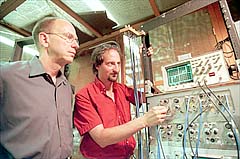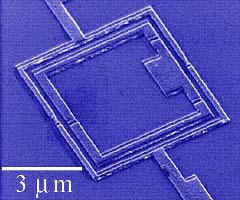July 11, 2000
Here, There and Everywhere: A Quantum State of Mind
By KENNETH CHANG


Vic DeLucia/The New York TimesDr. James E. Lukens, left, and Dr. Jonathan R. Friedman ask whether quantum mechanics holds for large, as well as subatomic, objects. Bottom, physicists at Delft University of Technology have put a 5-micrometer-wide loop of superconducting wire into a "quantum superposition" of two contradictory possibilities: in one, the current flows clockwise; in the other, current flows counterclockwise.
Related Articles
• The Nature of the Universe
n the realm of atoms and smaller particles, objects exist not so much as objects as mists of possibilities of being here or there and everywhere at the same time -- and then someone looks and the possibilities suddenly collapse to definite locations.
That is contrary to everyday experience where objects -- buses, tacks, friends -- exist at one place at one time. Either they are here, or they are not, and that does not depend on whether we look for them.
How the fuzziness of the atomic world, described by equations of quantum mechanics, solidifies into the larger, everyday world is a conundrum physicists have been largely able to ignore.
New experiments at United States and European laboratories have now pushed the eerie phenomena of quantum mechanics much closer to the everyday world with an experiment that is a simplified version of the concept of Schrödinger's cat.
In 1935, Erwin Schrödinger, the physicist who devised the central equation of quantum mechanics, described a thought experiment encapsulating the uneasy coexistence of the atomic and the everyday worlds.
A cat is placed in a sealed box. Also in the box is a device that contains a small amount of a radioactive element. There is a 50 percent chance that one of the unstable atoms will decay within an hour. If an atom decays, the device breaks open a poison-containing flask, killing the cat. If there is no decay, the cat lives.
Applying the rules of quantum mechanics to everyday objects produces perplexing implications.
It is not that the cat is definitely alive or dead and that one does not know which is true without looking. Instead, all possibilities exist. The cat, says quantum mechanics, oscillates between life and death and only when the box is opened is its fate decided.
In the thought experiment, the imaginary cat remains unharmed.
Instead of a cat, a team led by Dr. James E. Lukens and Dr. Jonathan R. Friedman, physicists at the State University of New York at Stony Brook, used a small square loop of superconducting wire.
The experiment combines two possibilities, known as a quantum superposition, for the direction of the flow of electric current: clockwise around the loop or counterclockwise.
The researchers measured an energy difference between the two states of the loop, a sign the current was a quantum superposition and not simply flipping directions.
Just as the cat is neither alive nor dead but a ghostly mix of the two possibilities, the current flows neither clockwise nor counterclockwise, but is a mix of the two possibilities.
Earlier demonstrations of quantum superposition showed an electron or an atom in more than one location at a time. The SUNY experiment shows that the flow of billions of electrons can also be coaxed into a quantum mechanical blur.
"We observe our car to be in one parking space and not the other, and for people to be on one side of the wall or the other," Dr. Friedman said. "But this says, at least on the scale of a hair-width size superconducting loop, we can have two of these macroscopically well-defined states at the same time. Which is something of an affront to our classical intuitions about the world."
The SUNY work, reported in the current issue of the journal Nature, is "the first one in which there has been reasonably foolproof evidence you do have a superposition of macroscopic quantum states," said Dr. Anthony J. Leggett, a professor of physics at the University of Illinois at Urbana-Champaign, who first proposed the experiment in 1985.
According to the rules of quantum mechanics, the strength of the magnetic field passing through the loop does not rise and fall smoothly, but jumps between certain discrete values. When the loop is placed in an external magnetic field, the loop spontaneously sets up an electrical current to generate an additional magnetic field, adjusting the field strength to one of the allowed values.
In the SUNY experiment, the loop was placed in a magnetic field equal to half of the first allowed value. Thus, the loop could set up either a current to raise the field strength to the first allowed value or, with equal probability, a current of equal magnitude flowing in the opposite direction to cancel out the external field.
The clockwise and counterclockwise currents differ in value by several microamps.
A measurement always gives one of the two possible answers, clockwise or counterclockwise, never a zero cancellation.
Physicists at the Delft University of Technology in the Netherlands have performed a similar experiment with similar results. An article describing their findings has been submitted to the journal Science.
Most physicists believe that the reason macroscopic objects do not appear as a quantum mechanical smudge of possibilities is a mechanism known as decoherence, whereby the continuous jostling against the surrounding environment nudges objects out of the blur of possibilities into one particular reality.
The SUNY and Delft experiments take the opposite tack: by removing all outside interference, an object can be coaxed into a quantum blur.
"The question remains, how far can we push this?" Dr. Friedman said. "Can we make things on the scale of cats?"
In addition to checking quantum mechanics at a larger scale, macroscopic quantum states could also be used in future quantum computers.
For Dr. Leggett, quantum mechanics at the macroscopic level is still uncertain -- and troubling. "It may bother me even more now," Dr. Leggett said. "I'm interested in the possibility that quantum mechanics, at some stage, may be wrong."
A few physicists have devised so-called macrorealistic theories to resolve the ambiguities of quantum mechanics. "What you get in quantum mechanics is not what you see," said Dr. Philip Pearle, a professor of physics at Hamilton College in Clinton, N.Y. "Schrödinger felt this acutely. He himself felt something with quantum mechanics was wrong."
Dr. Pearle and colleagues in Italy propose to add a term to Schrödinger's equation that, in effect, constantly jiggles the fabric of the universe. Atomic-scale objects only jiggle a little and thus remain a blur, which preserves the predictions of quantum mechanics. Larger objects, like people or the Moon, jiggle more and quickly fall into a definite here and there, which corresponds to everyday experience.
"The deeper question is, is nature really doing this?" Dr. Pearle said. "The second is, how is nature doing this?" He admits he has no direct evidence for the jiggling and no idea what would cause the jiggling.
An experiment measuring how one observation affects a later one should distinguish whether quantum mechanics or a macrorealistic theory rules the everyday world.
The difference between the two can be seen by thinking of a child swinging back and forth in the dark. The two quantum states -- clockwise versus counterclockwise current or the alive versus dead cat -- correspond to the child's being on the left- or right-hand side of the swing's arc.
Imagine shining a flashlight on the right-hand side of the swing and seeing nothing. In a macrorealistic theory, the child continues to swing back and forth, undisturbed.
In quantum mechanics, however, the mere act of looking, whether the child is seen or not, disturbs the possibilities because, as Dr. Leggett explains, the superposition has been destroyed.
In essence, in a quantum mechanical world, not seeing the child on the right-hand side resets the child's swing to the top of left side of the arc, altering the probabilities of where the child will be seen later.
And that, most physicists believe, is what the experiments will eventually show.
"I think most physicists, including myself, would be extremely surprised if quantum mechanics did fail for large objects," Dr. Lukens said. But, he added, "Every so often we are surprised."